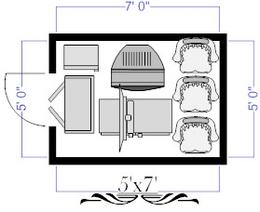Packing Tips
Make packing for storage easier on yourself by planning ahead. Start by listing all the items you are going to store and their approximate sizes. Also, gather up plenty of sturdy, corrugated cartons, packing paper, bubble wrap, sealing tape and marker pens, along with any furniture covers or shelving you intend to use in your storage unit.
Pack as much as you can in the same size boxes. Fill boxes tightly, but take care to neither over-pack or under-pack (bulging cartons tip when stacked, while half-full boxes tend to collapse). Use wadded up newsprint, bubblewrap, rags, towels, or blankets to fill in empty spaces. For maximum protection, seal cartons with tape.
Pack heavy items, such as books and tools, in small boxes. For easier handling, limit the weight of all cartons, regardless of size, to 30 lbs. or less.
Label all boxes. Clearly label boxes so you know their contents, and keep a list (as well as pictures and descriptions) at your home or office for reference. Mark clearly all boxes containing fragile items.
Clean and dry appliances before storing. Secure all movable parts with paper, or wedge and wrap paper pad around each item for protection. During transport, tape all doors shut, but remember to wedge them open for storage.
Tape or tie bed rails together. Mark the pieces for easier assembly later. Place covers or plastic bags on mattresses to keep them clean during storage.
Pack books flat to protect their spines. Line cartons with plastic and fill empty spaces with towels or packing paper. Protect chair legs by wrapping them in packing paper. Leave slipcovers on upholstered chairs and cover them with plastic chair covers.
Hang clothes and draperies in wardrobe boxes. Use lots of paper to pack dishes and glassware.
Place a layer of packing paper inside the bottom and top of cartons. Wrap each dish and glass separately and cushion them with crumpled paper. Plates are best stacked on edge.
Pack lamps and lampshades in individual boxes. Use plenty of clean paper or clothing for padding.
Pad mirrors and paintings with paper. Place them in special mirror packs or large boxes, and then mark the boxes.
Storage Tips
NEVER store live animal, perishables, liquids, explosives, flammable liquids and fuels, toxic materials, or other items that need a controlled environment. When in doubt, ask the Office or just don't store it!
Store valuable items towards the back of your unit; out of sight and behind other items.
Store items that you will need most often at the front of the unit.
When you pack your storage unit, create a center aisle for access to all items.
Do not place boxes directly on concrete floors, but use pallets or skids to prevent moisture absorption.
If you're storing tables and other furniture, remove legs and store the tabletops and sofas on end, so as to save space.
Old photographs tend to curl over time. To keep them flat, place them between two pieces of cardboard and tape them together.
Drain gasoline and oil from lawn mowers and other items with small engines.
Use trash cans to store shovels, hoes, and rakes
Mattresses should be covered and stored flat on level surfaces.
Use protective covers and treat wood surfaces before storing.
When storing metal items, wipe all metal surfaces with a rag containing a few drops of machine oil, so as to prevent rust.
Pack blankets, draperies, and dress clothes on the hanger in a wardrobe box.
Safety & Security Information
- Always use your access code when entering.
- Never unlock doors or use your gate access code for other people.
- Keep doors locked when not in use.
- Do not store valuable items in the front of the unit.
- Relock your unit with both the cylinder & the disklock after accessing your unit.
- Relock hall doors and check them.
- Always use your access code when leaving to reactivate unit alarm.
- Report any suspicious activity.














